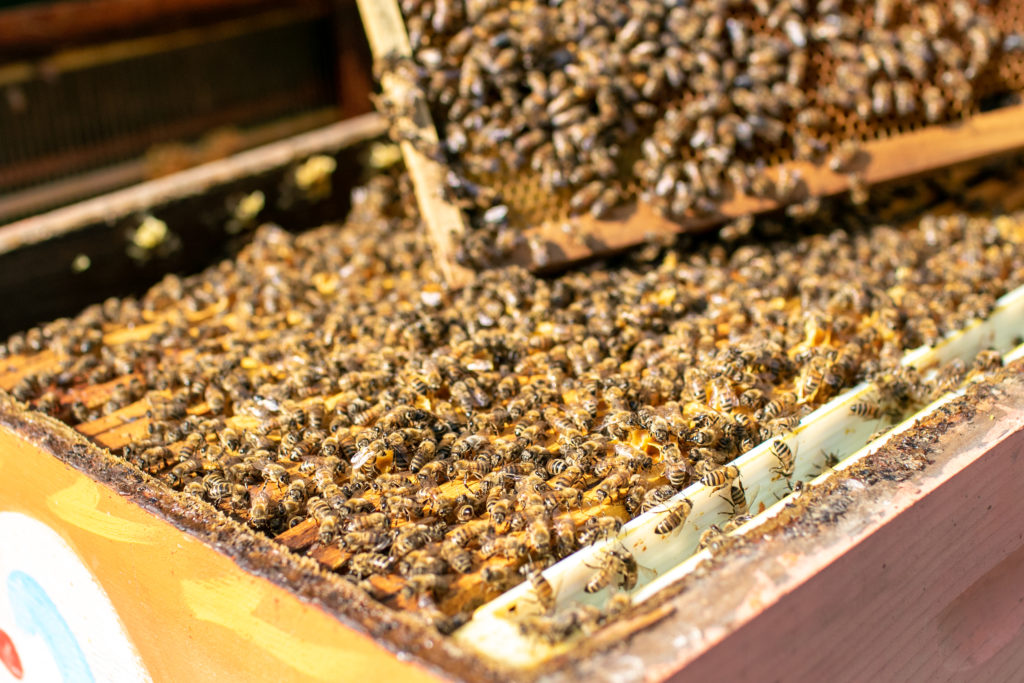
Having taken sustainable development to heart for a few decades now and focusing on solutions to our biggest challenges, I tend to think that issues which have been brought to our attention have positively evolved. Sadly that’s not the case but I know we have all the information to evolve as a species and co-exist respectfully with the complex ecosystems that we’re a part of. Speaking with Andrea, the beekeeper I always buy honey from, he introduced me to Luca Bosco and Marco Bergero. Thanks to these dedicated, passionate and knowledgeable young men, I found out that bees and pollinators are more threatened than ever. That’s how this interview came about and I learned how much more there is to do. If you know any hazelnut or almond growers please share this story. Christina Grozinger, Director of the Center for Pollination Research at Penn State confirms that exposure to fungicides, neonicotinoids and insecticides is causing great harm to pollinators. Engaging in conversations with the people we buy produce from is critical to understanding the impact of our choices.
Cristina: Today is World Biodiversity Day, and the UN wants to bring our attention to the complex dynamics that govern life on earth. Biodiversity is our greatest treasure and monitoring its health is complicated. We are in the Cuneo area to meet Luca, a beekeeper. Luca, why are bees the most precious sentinels of biodiversity?
Luca Bosco: Because everything that arrives in the hive collected by bees is the result of a synergy between different forms of life and, therefore, is a result of the environment’s biodiversity.
Cristina: What do your observations tell you?
Luca Bosco: That the bee’s situation, and pollinators in general, is very serious. We often see episodes of die-offs and poisonings in our hives. Unfortunately we find insecticides, fungicides and herbicides in the matrices of the hives. One herbicide in particular, the molecule glyphosate, is very serious because its discovery, especially in the hive’s honey matrix – maturing honey, is a precise clue. The molecule that is sprayed here can end up anywhere, we find it in the water, in the air, it inevitably ends up in the soil because it’s sprayed on the ground and we also find it in plant pollen and nectar. This is a clear indication that the ecosystem’s natural filters are somehow degrading.
Cristina: Luca, which crops are sprayed the most with these substances?
Luca Bosco: Here we find ourselves in an area of viticulture and coriliculture, so grapes and hazelnuts. In recent years, thanks to the work of the beekeepers association, viticulturists have learned to use pesticides wisely, without causing direct and serious harm to pollinators. On the other hand, as far as hazelnuts are concerned, the matter is still open to discussion because it’s a new crop and, at the moment, the agronomic practices in use leave much to be desired. They are a source of direct poisoning, somehow they’re also the cause of those systematic findings in the hive matrices, especially in this area. We want to appeal to those who grow hazelnuts to follow the path already taken by winemakers.
Cristina: Luca you are about to take some samples, what is their frequency and what are they for?
Luca Bosco: They’re monthly and are used to investigate the possible presence of chemical molecules. Experience tells us that we will most likely find them because in past years, their presence has unfortunately been very assiduous. We know that these molecules are harmful to bees, also because of their somewhat unique ability to purify environmental matrices by absorbing chemical molecules into their bodies, to their own detriment of course, but especially preserving the honey. Somehow, the honey always results pure.
Cristina: How phenomenal. Do you cross-reference this data with others?
Luca Bosco: We cross this data with other measurements that are carried out in the area, in particular with those carried out on the Tanaro River, which you can see just nearby, and the two surveys confirm the same thing, the ubiquitous presence of chemical molecules.
Cristina: Thank you Luca. This story touches all 17 Sustainable Development Goals. And what can we do? Talk with beekeepers as much as possible, understand the critical issues in our area and protect it in any way we can. It pays off for everyone. Occhio al futuro
On air May 22nd, 2021


